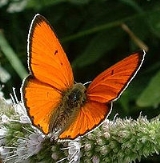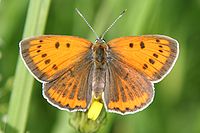
Large Copper
Encyclopedia
The Large Copper is a butterfly
of the family Lycaenidae
.The insect has a wide range occurring throughout the Northern Palearctic ecozone north to the middle taiga
zone (Euro-Siberian region).
subspecies of this butterfly (dispar) has been extinct for over 144 years (since 1864). Most of our knowledge of its life cycle
and ecology
comes from studies of the similar subspecies (batavus or batava) found in The Netherlands
. The species can be identified by the silvery hindwing undersides, from the large specimens of the related, more common, drier habitat species Lycaena virgaureae and Lycaena hippothoe
.

. The species has been in severe decline in Britain due to the great reduction of fen
habitat due to expansion of the human population
. In the rest of the Western Europe, the draining of wetlands and building and agricultural activity on shallow riverbanks has caused a strong decline. In Eastern Europe, undeveloped riverbanks and deltas are a habitat for the species, though even there it is somewhat threatened due increasing human influence on these areas.
There have been several reintroduction attempts to sites in both Britain
and Ireland
, but these have all ultimately failed. Research is now being conducted to see whether a further attempt is worthwhile in more extensive habitats available in the Norfolk Broads.
(the areas Weerribben and Wieden) in the Netherlands. Furthermore, it only feeds on Rumex hydrolapathum
, making it a vulnerable subspecies. To protect the subspecies, there is a conservation plan, mainly aimed at expanding its habitat.
Butterfly
A butterfly is a mainly day-flying insect of the order Lepidoptera, which includes the butterflies and moths. Like other holometabolous insects, the butterfly's life cycle consists of four parts: egg, larva, pupa and adult. Most species are diurnal. Butterflies have large, often brightly coloured...
of the family Lycaenidae
Lycaenidae
The Lycaenidae are the second-largest family of butterflies, with about 6000 species worldwide, whose members are also called gossamer-winged butterflies...
.The insect has a wide range occurring throughout the Northern Palearctic ecozone north to the middle taiga
Taiga
Taiga , also known as the boreal forest, is a biome characterized by coniferous forests.Taiga is the world's largest terrestrial biome. In North America it covers most of inland Canada and Alaska as well as parts of the extreme northern continental United States and is known as the Northwoods...
zone (Euro-Siberian region).
Subspecies
- L. d. dispar (Haworth, 1802) − England − Extinct
- L. d. rutila (Werneberg, 1864) − EuropeEuropeEurope is, by convention, one of the world's seven continents. Comprising the westernmost peninsula of Eurasia, Europe is generally 'divided' from Asia to its east by the watershed divides of the Ural and Caucasus Mountains, the Ural River, the Caspian and Black Seas, and the waterways connecting...
, CaucasusCaucasusThe Caucasus, also Caucas or Caucasia , is a geopolitical region at the border of Europe and Asia, and situated between the Black and the Caspian sea...
, Transcaucasia, N. Tien-Shan, W. Tien-Shan, Dzhungarsky Alatau, Ghissar
- L. d. festiva Krulikowsky, 1909 − UralUral (region)Ural is a geographical region located around the Ural Mountains, between the East European and West Siberian plains. It extends approximately from north to south, from the Arctic Ocean to the bend of Ural River near Orsk city. The boundary between Europe and Asia runs along the eastern side of...
, W. SiberiaSiberiaSiberia is an extensive region constituting almost all of Northern Asia. Comprising the central and eastern portion of the Russian Federation, it was part of the Soviet Union from its beginning, as its predecessor states, the Tsardom of Russia and the Russian Empire, conquered it during the 16th...
- L. d. dahurica (Graeser, 1888) − Transbaikalia, W.AmurAmurThe Amur or Heilong Jiang is the world's tenth longest river, forming the border between the Russian Far East and Northeastern China .-Course:...
- L. d. aurata Leech, 1887 − SiberiaSiberiaSiberia is an extensive region constituting almost all of Northern Asia. Comprising the central and eastern portion of the Russian Federation, it was part of the Soviet Union from its beginning, as its predecessor states, the Tsardom of Russia and the Russian Empire, conquered it during the 16th...
, E. Amur, Ussuri.
England, Ireland and Holland
The BritishUnited Kingdom
The United Kingdom of Great Britain and Northern IrelandIn the United Kingdom and Dependencies, other languages have been officially recognised as legitimate autochthonous languages under the European Charter for Regional or Minority Languages...
subspecies of this butterfly (dispar) has been extinct for over 144 years (since 1864). Most of our knowledge of its life cycle
Biological life cycle
A life cycle is a period involving all different generations of a species succeeding each other through means of reproduction, whether through asexual reproduction or sexual reproduction...
and ecology
Ecology
Ecology is the scientific study of the relations that living organisms have with respect to each other and their natural environment. Variables of interest to ecologists include the composition, distribution, amount , number, and changing states of organisms within and among ecosystems...
comes from studies of the similar subspecies (batavus or batava) found in The Netherlands
Netherlands
The Netherlands is a constituent country of the Kingdom of the Netherlands, located mainly in North-West Europe and with several islands in the Caribbean. Mainland Netherlands borders the North Sea to the north and west, Belgium to the south, and Germany to the east, and shares maritime borders...
. The species can be identified by the silvery hindwing undersides, from the large specimens of the related, more common, drier habitat species Lycaena virgaureae and Lycaena hippothoe
Purple-edged Copper
The Purple-edged Copper is a butterfly of the family Lycaenidae.* Length of male: 16–17 mm.* Period of flight: June–July, one generation, range around 1500 m.* Plants favoured: Rumex spp...
.

Conservation
This is one of the butterfly species classified as a priority for protection and re-introduction in the UK under its national Biodiversity Action PlanBiodiversity Action Plan
A Biodiversity Action Plan is an internationally recognized program addressing threatened species and habitats and is designed to protect and restore biological systems. The original impetus for these plans derives from the 1992 Convention on Biological Diversity...
. The species has been in severe decline in Britain due to the great reduction of fen
Fen
A fen is a type of wetland fed by mineral-rich surface water or groundwater. Fens are characterised by their water chemistry, which is neutral or alkaline, with relatively high dissolved mineral levels but few other plant nutrients...
habitat due to expansion of the human population
Overpopulation
Overpopulation is a condition where an organism's numbers exceed the carrying capacity of its habitat. The term often refers to the relationship between the human population and its environment, the Earth...
. In the rest of the Western Europe, the draining of wetlands and building and agricultural activity on shallow riverbanks has caused a strong decline. In Eastern Europe, undeveloped riverbanks and deltas are a habitat for the species, though even there it is somewhat threatened due increasing human influence on these areas.
There have been several reintroduction attempts to sites in both Britain
Great Britain
Great Britain or Britain is an island situated to the northwest of Continental Europe. It is the ninth largest island in the world, and the largest European island, as well as the largest of the British Isles...
and Ireland
Ireland
Ireland is an island to the northwest of continental Europe. It is the third-largest island in Europe and the twentieth-largest island on Earth...
, but these have all ultimately failed. Research is now being conducted to see whether a further attempt is worthwhile in more extensive habitats available in the Norfolk Broads.
Subspecies Lycaena dispar batava
The subspecies Lycaena dispar batava is only found in marshy areas in North West OverijsselOverijssel
Overijssel is a province of the Netherlands in the central eastern part of the country. The region has a NUTS classification of NL21. The province's name means "Lands across river IJssel". The capital city of Overijssel is Zwolle and the largest city is Enschede...
(the areas Weerribben and Wieden) in the Netherlands. Furthermore, it only feeds on Rumex hydrolapathum
Rumex hydrolapathum
Rumex hydrolapathum Huds. is a species of perennial herbaceous plants in the genus Rumex native to fens and freshwater banks of Europe and Western Asia...
, making it a vulnerable subspecies. To protect the subspecies, there is a conservation plan, mainly aimed at expanding its habitat.

